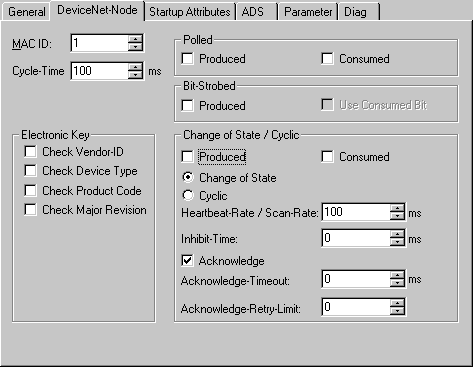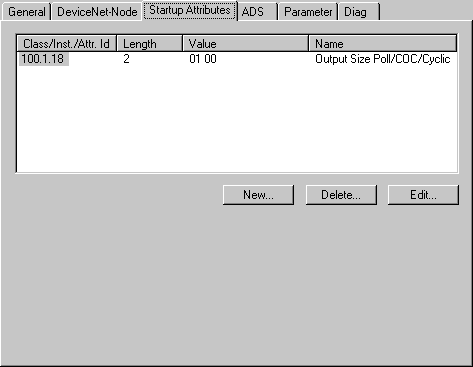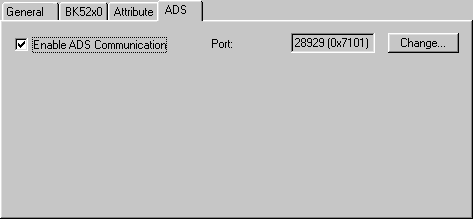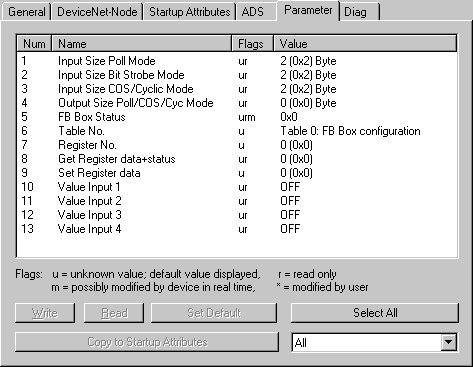DeviceNet Device
Select DeviceNet node to integrate general DeviceNet devices. You then need to enter the connection parameters for these devices.
"DeviceNet Node" tab

MAC Id: Sets the node ID of the DeviceNet participant (between 0 and 63). This value must comply with the value set at the node.
Cycle Time: Sets the cycle time for the I0 connection. This value is added to the Expected Packet Rate (EPR) attributes of the DeviceNet slave and acts as a timeout monitor for IO connections.
Electronic Key: Serves to check the devices within the network at the system StartUp. The electronic key is read from the devices at every system StartUp and compared with the saved configuration.
Polled: Produced/Consumed: Activation of the ”Polling” operating mode, cyclical writing and reading of IO data
Bit-Strobed: Produced/Consumed: Activation of the ”Bit Strobe” Operating Mode. With a broadcast message all nodes are requested to send their bit strobe message (up to 7 bytes input or status data).
Change of State / Cyclic: Produced/Consumed: Activation of "Change of State" operating mode, event controlled sending of IO data or ”Cyclic”, cyclical sending of IO data.
- Change of State / Cyclic: Selecting the Corresponding Operating Mode
- Heartbeat Rate / Scan Rate: In the "Change of State" mode the heartbeat rate gives the cycle time of the cyclical send of the lower-level (i.e. in addition to the event driven) IO data. In the ”Cyclic” operating mode the scan rate gives the cycle time of the IO data send.
Inhibit time: Delay period in the ”Change of State” operating mode inserts this pre-set delay period after a change of state before the IO data send.
Acknowledge Timeout: Time before the re-send in the event of faulty acknowledgement of a change of state / cyclical message.
Acknowledge Retry Limit: Maximum number of re-sends until IO connection goes into error mode.
K-Bus Update: Calculates the anticipated duration of a complete update of the terminal bus (according to the number of connected terminals).
Input Diagnosis:
Each DeviceNet fieldbus node contains one diagnostic input byte which signals the status of the current slave during the running time and can be linked, for example with the PLC.
Error Code | Description | Troubleshooting |
|---|---|---|
0x02 | Station not exists, device is not responding | Inspect the device, verify connections, check cabling |
0x05 | Parameter fault | Check explicite access to devices attributes, check object class, instance, and attribute id |
0x07 | Configuration fault | Check configuration settings of device |
0x09 | Device is deactivated | Check master and device configuration |
Error Code | Description | Troubleshooting |
|---|---|---|
0x00 | No data exchange between node and master | Inspect the field device, verify connections, check cabling |
0x01 | Data Exchange is active |
|
”Attributes” tab

DeviceNet attributes/parameters sent to the node at StartUp are displayed/managed on this page. Other inputs can be managed using ”New”, ”Delete” and ”Edit”.
”ADS” tab

In order to be able to read and write attributes during the running time (e.g. from the PLC), the node (Bus Coupler) can be allocated an ADS port. These can be used to read / write attributes via ADS read requests / ADS write requests.
The ADS IndexGroup contains the ClassId and the ADS IndexOffset contains InstanceId and AttributeId (InstanceId * 256 + AttributeId).
Diagnostic data
The DeviceNet status data from a node can be read by any TwinCAT program via ADS and/or signalled to any TwinCAT program.
”Parameter” tab

The parameters are read from the EDS when creating the box. If the system has not started up yet, the EDS default value is always displayed under the value input.